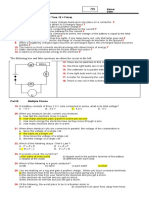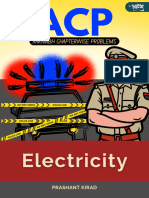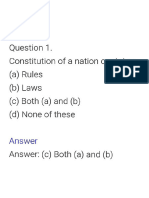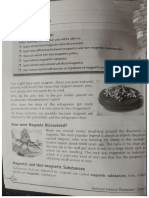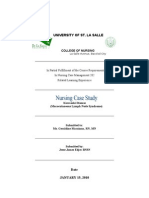0 ratings0% found this document useful (0 votes)
37 viewsElectric Current and Its Effects-1
Electric Current and Its Effects-1
Uploaded by
GAJALAKSHMI LThis document contains a worksheet with 41 multiple choice questions about electric current and its effects. The questions cover topics like electric circuit components, electromagnets, safety devices, symbols used to represent batteries and cells, and how various factors affect resistance and heat production in wires. The worksheet is intended for 7th grade students and is part of a physics lesson on electricity.
Copyright:
© All Rights Reserved
Available Formats
Download as PDF, TXT or read online from Scribd
Electric Current and Its Effects-1
Electric Current and Its Effects-1
Uploaded by
GAJALAKSHMI L0 ratings0% found this document useful (0 votes)
37 views3 pagesThis document contains a worksheet with 41 multiple choice questions about electric current and its effects. The questions cover topics like electric circuit components, electromagnets, safety devices, symbols used to represent batteries and cells, and how various factors affect resistance and heat production in wires. The worksheet is intended for 7th grade students and is part of a physics lesson on electricity.
Copyright
© © All Rights Reserved
Available Formats
PDF, TXT or read online from Scribd
Share this document
Did you find this document useful?
Is this content inappropriate?
This document contains a worksheet with 41 multiple choice questions about electric current and its effects. The questions cover topics like electric circuit components, electromagnets, safety devices, symbols used to represent batteries and cells, and how various factors affect resistance and heat production in wires. The worksheet is intended for 7th grade students and is part of a physics lesson on electricity.
Copyright:
© All Rights Reserved
Available Formats
Download as PDF, TXT or read online from Scribd
Download as pdf or txt
0 ratings0% found this document useful (0 votes)
37 views3 pagesElectric Current and Its Effects-1
Electric Current and Its Effects-1
Uploaded by
GAJALAKSHMI LThis document contains a worksheet with 41 multiple choice questions about electric current and its effects. The questions cover topics like electric circuit components, electromagnets, safety devices, symbols used to represent batteries and cells, and how various factors affect resistance and heat production in wires. The worksheet is intended for 7th grade students and is part of a physics lesson on electricity.
Copyright:
© All Rights Reserved
Available Formats
Download as PDF, TXT or read online from Scribd
Download as pdf or txt
You are on page 1of 3
VELAMMAL BODHI CAMPUS
ELECTRIC CURRENT AND ITS EFFECTS
Class: VII (IIT) WORK SHEET-1 SUBJECT: PHYSICS
1. An electric component used as a safety device in electric circuits is
a) Switch b) Fuse c) Cell d) Electric wires
2. The electric bell makes use of
a) a U-shaped electromagnet b) a bar-shaped electromagnet
c) a ring-shaped electromagnet d) no electromagnet
3. In an electric circuit, the current starts form:
a) The negative terminal of the battery b) The positive terminal of the battery
c) Either of the terminals of the battery d) none of the terminals of the battery
4. The strength of an electromagnet does not depend upon
a) The current flowing through the coil b) The number of turns of the coil
c) The insulating material of the coil d) the length of the electromagnet
5. In the symbol of an electric cell, the longer line represents the terminal, and the thicker and
shorter line represents the terminal
a) negative, positive b) neutral, positive c) neutral, negative d) positive, negative
6. The device used to prevent the flow of excess current in the circuit is:
a) Switch b) Fuse c) Bulb d) Coil
7. A current carrying coil of an insulated wire wrapped around a piece of soft iron becomes
a) A filament b) An electromagnet c) A fuse d) A conductor
8. The thin wire inside a bulb is
a) Coil b) Magnet c) Filament d) None of these
9. The bulb in an electric circuit glows because of
a) Magnetic effect of current b) Heating effect of current
c) Chemical effect of current d) none of these
10. Which of the following is not a source of electric current?
a) Car battery b) Dry cell c) Cell d) Electromagnet
11. A battery is a group of
a) Only two cells b) Two or more cells c) Only single cell d) All of these
12. Key or switch in circuit is placed
a) Left side of the battery b) Right side of the battery
c) Anywhere in the circuit d) near the positive terminal of the bulb
13. The coil of wire contained in heater is known as
a) Component b) Circuit c) Element d) Spring
14. Which mark is necessary on electric appliances?
a) ISI b) FICC c) AGMARK d) KSK
15. Which of the following is/are true about CFLs?
a) Reduce power wastage b) Fix in ordinary bulb holders
c) Both a and b d) neither a nor b
16. Which of the following is not a circuit element?
a) Potential difference b) Voltmeter c) Resistor d) Battery
17. The necessary requirement for a fuse wire is
a) Conductor with low melting point b) Conductor with high melting point
c) Insulator with low melting point d) Insulator with high melting point
18. Mark out the correct statement.
a) Fuses and MCBs are safety device b) Fuses are safety device but MCBs are not
c) MCBs are safety device but fuses are not d) neither fuses not MCBs are safety device.
19. Which of these appliances does not use an electromagnet?
a) Washing machine b) Refrigerator c) Room heater d) Electric bell
20. The shorter, thicker vertical line in the symbol of a cell represents
a) The positive terminal b) The negative terminal
c) The direction of current d) none of these
21. The longer, thinner line in the symbol of a cell denotes
a) The positive terminal b) The negative terminal
c) The direction of current d) none of these
22. Which of the following is an electrical conductor?
a) Silver b) Cork c) Silver-colored plastic d) Wood
23. In which circuit will the bulb or bulbs glow the brightest?
a) A simple circuit with one bulb and one cell b) A simple circuit with one bulb and two cells
c) A simple circuit with two bulbs and one cell d ) a simple circuit with two bulbs and two cells
24. Why is electrical wiring usually covered with a layer of plastic?
a) To make it strong b) To help electricity flow in it
c) To make it safe d) to make it beautiful
25. Rizvi has connected two bulbs across two cells in a simple circuit. How can she make the bulbs
dimmer?
a) Replace one of the cells with a cork b) Replace one of the cells with a wire
c) Replace one of the bulbs with a cork d) Replace one of the bulbs with a wire
26. Pooja makes a simple circuit with one bulb and five cells. The bulb lights for an instant and then
goes out. It happened because
a) Electricity could not flow through the circuit
b) Too much electricity passed through the bulb filament
c) The wires melted in the heat d) All of these
27. Why is electrical wiring usually made from copper and not silver?
a) Copper is a better conductor b) Copper is a better insulator
c) Copper is less expensive d) Copper is non magnetic
28. An electric heater is used by us to convert electrical energy to
a) Heat energy b) Light energy c) Chemical energy d) Both a and b
29. If you place a compass near a current carrying wire, it will
a) Get deflected b) Get charged c) Get hot d) Glow brightly
30. When the two terminals of a cell are connected directly with a wire, then
a) More electrical energy is stored in the cell b) The chemicals get used up very fast
c) No current flows d) the cell explodes
31. Which of the following statements regarding an electromagnet is NOT true?
a) Insulated wire is wound around it b) It works only in the presence of electricity.
c) It is used in fans and radio d) it is a permanent magnet
32. Electricians wear rubber gloves because it is
a) Soft b) Water proof c) An insulator d) Inexpensive
33. Which of the following does not belong to the group formed by the others?
a) Copper coin b) Steel spoon c) Wooden ruler d) Iron nail
34. Iron is used for making electromagnet; not steel, nickel, cobalt because
a) Iron is cheap and easily available
b) b) Iron is a good conductor of electricity
c) When current is switched off in the coil of an electromagnet made of iron, iron loses all its
magnetism
d) None of these
35. Which one of the following phenomenon occurs when two naked wires of electricity supply line
touch each other?
a) Overloading b) Short-circuiting c) Lightening d) None of these
36. The electric fuse work on which one of the following phenomenon?
a) Chemical effect of current b) Magnetic effect of current
c) Heating effect of current d) none of these
37. On which of the following the resistance of wire depends?
a) Length of the wire b) Thickness of the wire c) Material of the wire d) All of these
38. In which of the following conditions, amount of heat produced in a current carrying wire, will
increase?
a) When amount of current passing in the wire is increased
b) When amount of current passing in the wire is decreased
c) When terminals of the wire are changed
d) d) None of these
39. Which one of the following is the best conductor of electricity?
a) Silver b) Copper c) Aluminum d) Iron
40. Magnetic effect of current was discovered by
a) Thomas Jefferson b) Hans Christian Oersted
c) Fleming d) Louis Pasteur
41. What is overloading?
a) Touching of live wire with the neutral wire
b) Touching of live wire with the earth wire
c) Touching of neutral wire with the earth wire
d ) Putting more current across a wire than if can handle.
You might also like
- Visto Home Test - 2 - Class 6Document10 pagesVisto Home Test - 2 - Class 6GAJALAKSHMI LNo ratings yet
- Electricity ExamDocument4 pagesElectricity Examjorolan.annabelle100% (2)
- Tle Major Test Set 010 Basic Electricity 1Document9 pagesTle Major Test Set 010 Basic Electricity 1Charmaine NiebresNo ratings yet
- Electric Current and Its Effects - MCQDocument9 pagesElectric Current and Its Effects - MCQMinuteBrain LearningNo ratings yet
- Chemical Effects of Electric CurrentDocument4 pagesChemical Effects of Electric Currentyuvaneshsridhar2No ratings yet
- Electricity AssignmentDocument4 pagesElectricity AssignmentAjit Kumar BeheraNo ratings yet
- Physics ReviewerDocument5 pagesPhysics ReviewerEllah BangalisanNo ratings yet
- Magnetism and Electricity TestDocument5 pagesMagnetism and Electricity Testmrshong5bNo ratings yet
- A 37 Dgca MCQ Mod Electrical 2022Document9 pagesA 37 Dgca MCQ Mod Electrical 2022Jeans BazzarNo ratings yet
- vvm mcq on electricityDocument4 pagesvvm mcq on electricitysuparna.jash86No ratings yet
- Eletrical McqsDocument7 pagesEletrical McqsPravin Hande100% (1)
- Close Exam 3Document4 pagesClose Exam 3Joel Morada BalanNo ratings yet
- Shap Pak Heung Rural Committee Kung Yik She Secondary尸 SchoolDocument11 pagesShap Pak Heung Rural Committee Kung Yik She Secondary尸 Schools230033No ratings yet
- 1709035-Class 7 - Science - Electric Current and Its Effects - WS With Ans. - SumaDocument7 pages1709035-Class 7 - Science - Electric Current and Its Effects - WS With Ans. - SumaSeema KumariNo ratings yet
- (Class 6) CH - Electricity and CircuitsDocument3 pages(Class 6) CH - Electricity and CircuitsSnigdha GoelNo ratings yet
- MCQ Hots - ElectricityDocument15 pagesMCQ Hots - Electricityvidhan tiwariNo ratings yet
- MULTIPLE CHOICE (Choose The Letter That Corresponds To The Correct Answer)Document4 pagesMULTIPLE CHOICE (Choose The Letter That Corresponds To The Correct Answer)Rex Chambers Ladao100% (1)
- HDHW Mcq-Ar Current Electricity Xii 2024Document10 pagesHDHW Mcq-Ar Current Electricity Xii 2024Shashwat SinghNo ratings yet
- Khalid PhysicsDocument7 pagesKhalid PhysicsKhalidHassanNo ratings yet
- Name: Form: Class: Teacher: InstructionDocument5 pagesName: Form: Class: Teacher: Instruction19daniell.parchmentNo ratings yet
- Current Electricity (1)Document8 pagesCurrent Electricity (1)juanfateen5888No ratings yet
- Circuitrix EventDocument6 pagesCircuitrix EventNikhil KumarNo ratings yet
- Household CircuitsDocument8 pagesHousehold CircuitsqueenjoseNo ratings yet
- Electricity Practice OSSD AnswersDocument5 pagesElectricity Practice OSSD AnswersocNo ratings yet
- Aarambh Chapterwise Problems Aarambh Chapterwise ProblemsDocument20 pagesAarambh Chapterwise Problems Aarambh Chapterwise Problemsszeba0364No ratings yet
- Maharishi Vidya Mandir Senior Secondary School, Thiruvottiyur, Chennai - 19. Class: Vi Subject: Science Electricity and Circuits MCQ Worksheet: 1Document2 pagesMaharishi Vidya Mandir Senior Secondary School, Thiruvottiyur, Chennai - 19. Class: Vi Subject: Science Electricity and Circuits MCQ Worksheet: 1bhavani.perfectNo ratings yet
- Pec Rme 2Document7 pagesPec Rme 2Geri Isabel TampusNo ratings yet
- Techtronics Round - 1Document7 pagesTechtronics Round - 133ECEC1 5No ratings yet
- MCQ of Basic ElectricalDocument11 pagesMCQ of Basic Electricalkibrom atsbhaNo ratings yet
- Objectives Questions (Electronic Devices Circuits (WWW - Egate.ws)Document11 pagesObjectives Questions (Electronic Devices Circuits (WWW - Egate.ws)Satish Bojjawar0% (1)
- MCQ On TransformerDocument13 pagesMCQ On Transformerkhan adilNo ratings yet
- Fundamentals of CircuitsDocument56 pagesFundamentals of CircuitskalebwondwossentNo ratings yet
- medical physics key (1)Document8 pagesmedical physics key (1)Rejaa RiazNo ratings yet
- Applied Electronics IDocument55 pagesApplied Electronics Imelkamuab16No ratings yet
- Living Science Electric Current and Its Effects: AnswerDocument11 pagesLiving Science Electric Current and Its Effects: AnswerNaitik Singh100% (1)
- Electricity Grade 8 - Quizizz 2Document4 pagesElectricity Grade 8 - Quizizz 2Vanessa Christonette SistosoNo ratings yet
- Physics 40 Marks ch1Document3 pagesPhysics 40 Marks ch1Sanjay NayakNo ratings yet
- Phy 16 NotesDocument16 pagesPhy 16 Notesapi-248642018100% (1)
- BỘ NGÂN HÀNG CÂU HỎI ĐỀ THI KẾT THÚC HỌC PHẦN TỰ ĐỘNG HÓADocument10 pagesBỘ NGÂN HÀNG CÂU HỎI ĐỀ THI KẾT THÚC HỌC PHẦN TỰ ĐỘNG HÓANeon GamingNo ratings yet
- Unit 1 MCQ QuestionsDocument24 pagesUnit 1 MCQ Questionsanand anithaNo ratings yet
- ElectronicsDocument12 pagesElectronicsGlaynore PindogNo ratings yet
- 21PYB102J-Unit-I-Question BankDocument17 pages21PYB102J-Unit-I-Question Bankbalavignesh4707No ratings yet
- 10phy GAE4Document5 pages10phy GAE4BehruzNo ratings yet
- Electricity ACPDocument7 pagesElectricity ACPmr.stranger2314No ratings yet
- Technical Habilis 2Document6 pagesTechnical Habilis 2EugeneNo ratings yet
- 18PYB103J Unit I Question BankDocument5 pages18PYB103J Unit I Question Banksrinivas50% (2)
- JEE - Mains - Current - Electricity - Questions NewDocument8 pagesJEE - Mains - Current - Electricity - Questions NewcodeakashcodeNo ratings yet
- 311305_-_Basic_Physics_-_Unit_Test_-_2_030224Document5 pages311305_-_Basic_Physics_-_Unit_Test_-_2_030224neelam.bandaNo ratings yet
- 12 Physics Ch-3 WSDocument3 pages12 Physics Ch-3 WSyashverma2786No ratings yet
- 120 Top Most Current ELECTRICITY - Electrical Engineering Multiple Choice Questions and AnswersDocument19 pages120 Top Most Current ELECTRICITY - Electrical Engineering Multiple Choice Questions and AnswersVijay Yadav BahoodurNo ratings yet
- EDC - Sanfoundry 1Document13 pagesEDC - Sanfoundry 1shailiayushNo ratings yet
- Worksheet Physics VIIDocument10 pagesWorksheet Physics VIIShahidul Hassan MontiNo ratings yet
- Electronic Devices Objective Questions Answers 03Document2 pagesElectronic Devices Objective Questions Answers 03Vinayan K PNo ratings yet
- M 3Document11 pagesM 3KHAIREDDIN BUSINESSNo ratings yet
- Science Assessments 2Document9 pagesScience Assessments 2Chaira RenegadoNo ratings yet
- Electronics ReviewerDocument73 pagesElectronics ReviewerJonah DelaniNo ratings yet
- Class 7 Science Electric Current and Its Effects MCQs, Multiple Choice QuestionsDocument14 pagesClass 7 Science Electric Current and Its Effects MCQs, Multiple Choice QuestionsMiddle VvvNo ratings yet
- Unit 2Document11 pagesUnit 2Jagdev SinghNo ratings yet
- Ch8 - Current ElectricityDocument3 pagesCh8 - Current Electricitygangwani.tanishqNo ratings yet
- MCQDocument104 pagesMCQdinesh chauhan100% (1)
- Ruling CountryDocument9 pagesRuling CountryGAJALAKSHMI LNo ratings yet
- 5.early EmpiresDocument5 pages5.early EmpiresGAJALAKSHMI LNo ratings yet
- GR 6 Cat-2 RollDocument2 pagesGR 6 Cat-2 RollGAJALAKSHMI LNo ratings yet
- G8C1 One WordDocument59 pagesG8C1 One WordGAJALAKSHMI LNo ratings yet
- Viii - Biology Part Test Cat 1Document6 pagesViii - Biology Part Test Cat 1GAJALAKSHMI LNo ratings yet
- PA-3 English Revision WorksheetDocument11 pagesPA-3 English Revision WorksheetGAJALAKSHMI LNo ratings yet
- Grade 4 - LN 3Document6 pagesGrade 4 - LN 3GAJALAKSHMI LNo ratings yet
- Grade Iv LN 10 Common NotesDocument6 pagesGrade Iv LN 10 Common NotesGAJALAKSHMI LNo ratings yet
- Class-6... Home Test-2Document11 pagesClass-6... Home Test-2GAJALAKSHMI L100% (1)
- Physics MCQ and Olympiad Book PagesDocument11 pagesPhysics MCQ and Olympiad Book PagesGAJALAKSHMI LNo ratings yet
- Books Doubtnut Question BankDocument142 pagesBooks Doubtnut Question BankGAJALAKSHMI LNo ratings yet
- Civics - Ln-24 Local Self-Government, Rural and UrbanDocument4 pagesCivics - Ln-24 Local Self-Government, Rural and UrbanGAJALAKSHMI LNo ratings yet
- Ch-18 India Physical FeaturesDocument3 pagesCh-18 India Physical FeaturesGAJALAKSHMI LNo ratings yet
- The Shawshank Redemption (1994) 9.2Document51 pagesThe Shawshank Redemption (1994) 9.2Renda RachmanNo ratings yet
- Draft: Chapter 1: Golf Course Design & Construction Best Management PracticesDocument10 pagesDraft: Chapter 1: Golf Course Design & Construction Best Management PracticesshanuhiteshNo ratings yet
- University of Zakho Mechanical Engineering Department 2 Year 2019-2020 Mechanical Lab/ ThermodynamicsDocument3 pagesUniversity of Zakho Mechanical Engineering Department 2 Year 2019-2020 Mechanical Lab/ ThermodynamicsNorvinyeLorlortorYekoNo ratings yet
- Designing Websites With InkscapeDocument23 pagesDesigning Websites With InkscapeValney FilhoNo ratings yet
- X-Tite EpoxyGrout 150 - Job - 20220913Document3 pagesX-Tite EpoxyGrout 150 - Job - 20220913jasonNo ratings yet
- Star Fleet Command Manual - Volume XIIIDocument464 pagesStar Fleet Command Manual - Volume XIIIEndre Bujtas100% (1)
- Materi Listening ComprehensionDocument7 pagesMateri Listening ComprehensionEka YulianingsihNo ratings yet
- Interaction ModelsDocument8 pagesInteraction ModelsVishal TalrejaNo ratings yet
- Math F4C7 Graphs of Motion - Phase Three '23Document19 pagesMath F4C7 Graphs of Motion - Phase Three '23sachveenNo ratings yet
- Changes of State WorksheetDocument3 pagesChanges of State WorksheetJennie LanitNo ratings yet
- Short Circuit Analysis Lecture Notes PDFDocument107 pagesShort Circuit Analysis Lecture Notes PDFpsychic_jason00713190% (1)
- Standout Mixes ChecklistDocument3 pagesStandout Mixes ChecklistAndy ferrisNo ratings yet
- AudioPipe TXXbd215 Users ManualDocument9 pagesAudioPipe TXXbd215 Users ManualjustmeNo ratings yet
- Tools For Strategic Planning:: What Works BestDocument36 pagesTools For Strategic Planning:: What Works BestImprovingSupportNo ratings yet
- Home Science DissertationDocument6 pagesHome Science DissertationDltkCustomWritingPaperSingapore100% (1)
- Rapport-Marco-Polo-Hunter-Famille-Biden (1) (1) - Pages-81Document5 pagesRapport-Marco-Polo-Hunter-Famille-Biden (1) (1) - Pages-81cofutefNo ratings yet
- Input DevicesDocument4 pagesInput DevicesMaria Riza Maaya LaurdausNo ratings yet
- World of Knowledge Yr 4 KSSR 2014Document6 pagesWorld of Knowledge Yr 4 KSSR 2014Kazhimah HanaNo ratings yet
- Design of Double Pipe Heat Exchanger: Mrs. Kirti B.Zare, Ms. Dipika Kanchan, Ms. Nupur PatelDocument14 pagesDesign of Double Pipe Heat Exchanger: Mrs. Kirti B.Zare, Ms. Dipika Kanchan, Ms. Nupur PatelFranceNo ratings yet
- Can I Move My LabVIEW FPGA Project To A New Location Without RecompilingDocument4 pagesCan I Move My LabVIEW FPGA Project To A New Location Without RecompilingOmar Chayña VelásquezNo ratings yet
- Optimization of The Load-And-Haul Operation at An Opencast CollieryDocument8 pagesOptimization of The Load-And-Haul Operation at An Opencast CollieryTimmy ChawazNo ratings yet
- Stresses On Different Civic Amenities To Improve Standard of LivingDocument7 pagesStresses On Different Civic Amenities To Improve Standard of LivingShanwaz SiddiquiNo ratings yet
- Christenhusz 2011 Et Al Phytotaxa19 Gymnosperms 55 70Document16 pagesChristenhusz 2011 Et Al Phytotaxa19 Gymnosperms 55 70Aldo BarelaNo ratings yet
- Kawasaki Disease-Case-Study LATEST CHANGESDocument24 pagesKawasaki Disease-Case-Study LATEST CHANGESJesse James Advincula Edjec100% (7)
- About Welding Process 42Document1 pageAbout Welding Process 42XerexNo ratings yet
- Attachment 1Document21 pagesAttachment 1anthony.onyishi.242680No ratings yet
- Review Paper On Gearless Power Transmission Offset Parallel Shaft Coupling IJERTV3IS030168Document4 pagesReview Paper On Gearless Power Transmission Offset Parallel Shaft Coupling IJERTV3IS030168Siddhartha JainNo ratings yet
- Cplus 2Document3 pagesCplus 2BenjaminBenNo ratings yet
- BSP - Basic Guidelines in Establishing BanksDocument5 pagesBSP - Basic Guidelines in Establishing BanksKAKKAMPI100% (2)
- Project FileDocument13 pagesProject FileAnasAhmedNo ratings yet























